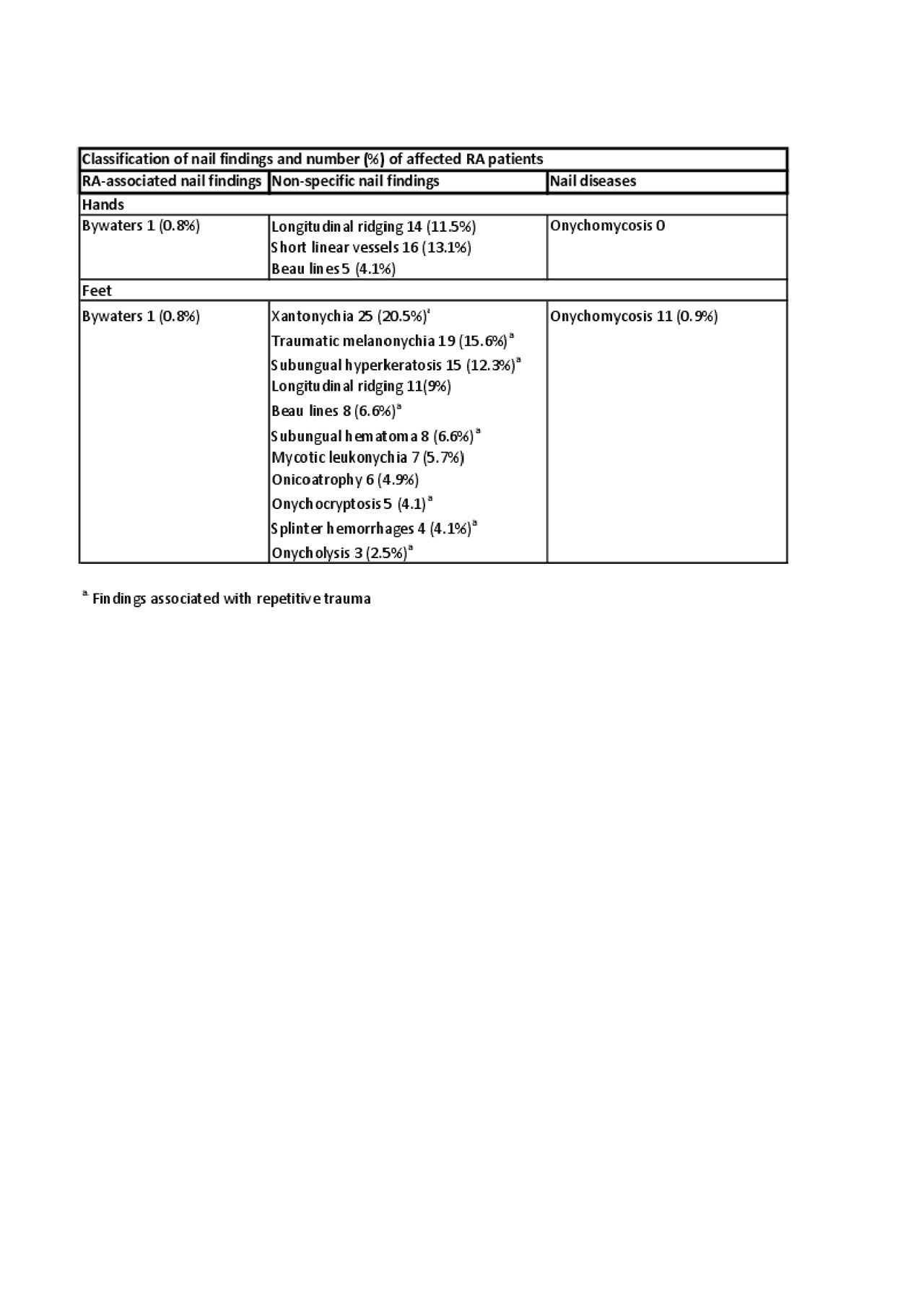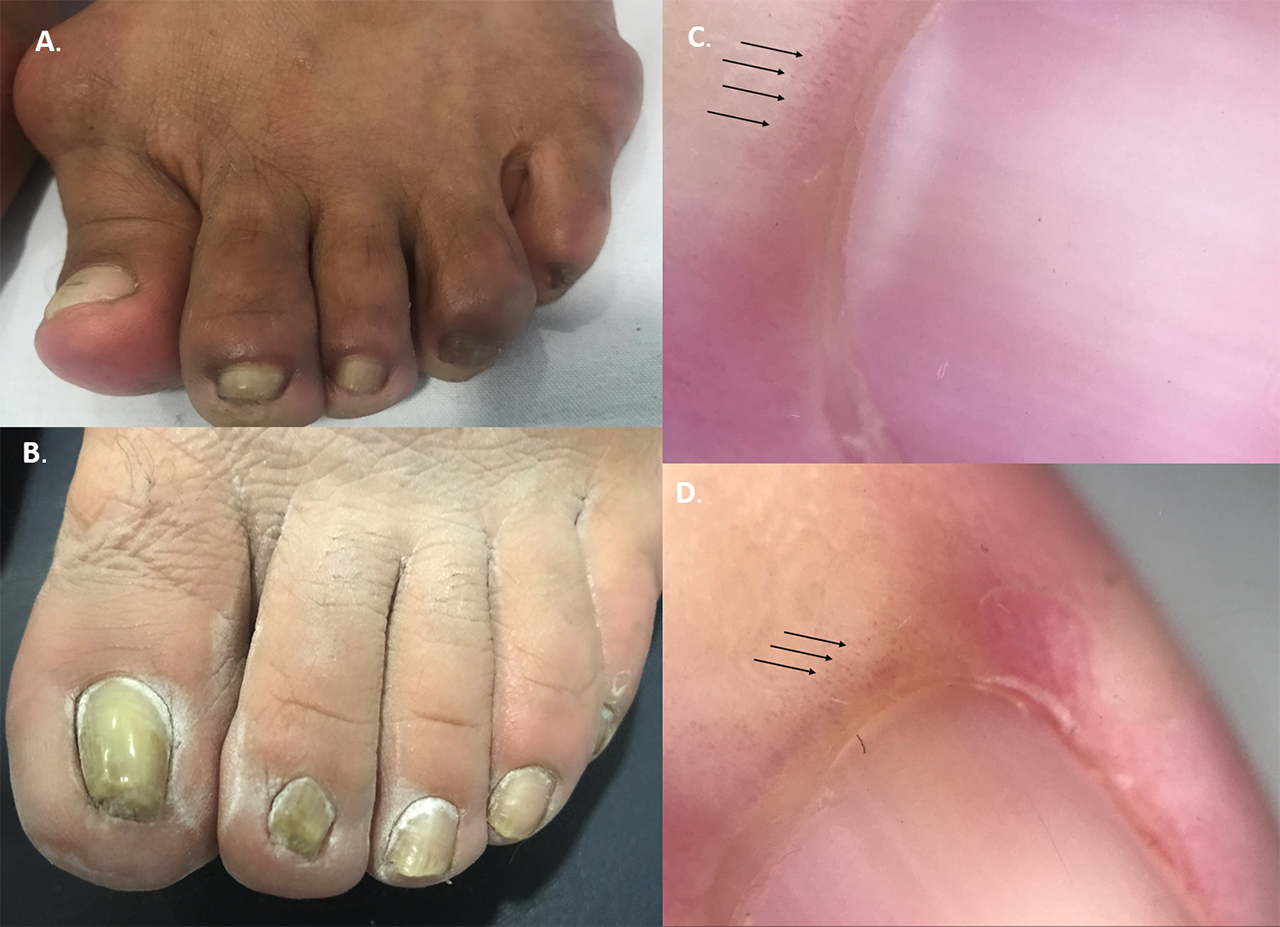Session Information
Date: Sunday, November 10, 2019
Title: RA – Diagnosis, Manifestations, & Outcomes Poster I: Risk Factors, Predictors, & Prognosis
Session Type: Poster Session (Sunday)
Session Time: 9:00AM-11:00AM
Background/Purpose: Different dermatological changes and nail abnormalities have been reported in rheumatoid arthritis (RA) patients, some of which are specifically associated with the disease, while others are non-specific. Whether nail changes are associated with disease activity and/or damage has not been properly assessed.
Methods: We performed a cross-sectional study in patients from an early RA cohort, which was initiated in 2004. Up to April 2019, the cohort had 145 patients with active follow-up. All patients were invited to participate and 122 agreed to have a standardized dermatological and nail screening exam. Toenail findings were classified as RA-related findings, RA-unrelated findings and nail-specific diagnoses, using standardized definitions. We described the main findings of the toenail evaluation, as well as their association with different disease parameters.
Results: At study entry, patients had a median age of 45.5 years (IQR 36-58), and most of them were female (91%), with substantial disease duration (median of 9 years [5-13]). The majority of patients (80.3%) had DAS28 remission and 46.7% had erosive disease.
There were 79 patients (64.8%) with nail findings: 62 (78.5%) in toenails, 44 (55.7%) in fingernails and 27 (34.2%) in both (Table 1). Patients with toenail abnormalities (n=60) showed higher disability, as per the HAQ-DI (p=0.019). Onychomycosis was found in 11 patients (9%), and the only associated variable was a higher cumulative DAS28 within the previous year: median (IQR) DAS28 of 2.57 (1.97-3.03) vs. 1.89 (1.47-2.48), p=0.047.
We grouped patients with toenail findings which could be attributed to trauma (Table 1); there were 58 patients (47.5%) with one or more lesions and their data were compared to those without these abnormalities (Table 2). Patients from the former group were older (p≤0.001), had a longer disease duration (p=0.034), a higher prevalence erosive disease (p=0.002) and a higher cumulative DAS28 during the first 2 years of follow-up in the cohort (p=0.026). After multivariate analysis, age (Exp β 1.04, 95% CI 1.008-1.073, p=0.014) and erosive disease (Exp β 2.564, 95% CI 1.175-5.598, p=0.018) remained significantly associated with traumatic toenail lesions.
Conclusion: Nail lesions, particularly in toenails, are highly prevalent in RA patients. Although most of them are non-specific, toenail findings suggestive of repetitive trauma may be considered a surrogate marker of disease damage. Routinely performing dermatological exams to RA patients may detect clinically relevant information and foster a multidisciplinary care.
References:
-Michel C, et al, Br J Dermatol. 1997; 137(6):958-62.
-Sayah A, et al. J Am Acad Dermatol 2005; 53(2):191-209
-Parra-Salcedo F, et al. Arthritis Res Ther 2015; 17:34
1C and 1D. Dermatoscopical view of the proximal nail fold showing short linear vessels
To cite this abstract in AMA style:
Pascual-Ramos V, Méndez-Flores S, Domínguez-Cherit J, Sánchez-Cárdenas A, Barrera-Vargas A, Merayo-Chalico J, Contreras-Yáñez I. Nail Abnormalities in a Cohort of Rheumatoid Arthritis Patients: Repetitive Trauma-Related Findings in Toenails Are Associated with Radiographic Damage [abstract]. Arthritis Rheumatol. 2019; 71 (suppl 10). https://acrabstracts.org/abstract/nail-abnormalities-in-a-cohort-of-rheumatoid-arthritis-patients-repetitive-trauma-related-findings-in-toenails-are-associated-with-radiographic-damage/. Accessed .« Back to 2019 ACR/ARP Annual Meeting
ACR Meeting Abstracts - https://acrabstracts.org/abstract/nail-abnormalities-in-a-cohort-of-rheumatoid-arthritis-patients-repetitive-trauma-related-findings-in-toenails-are-associated-with-radiographic-damage/



